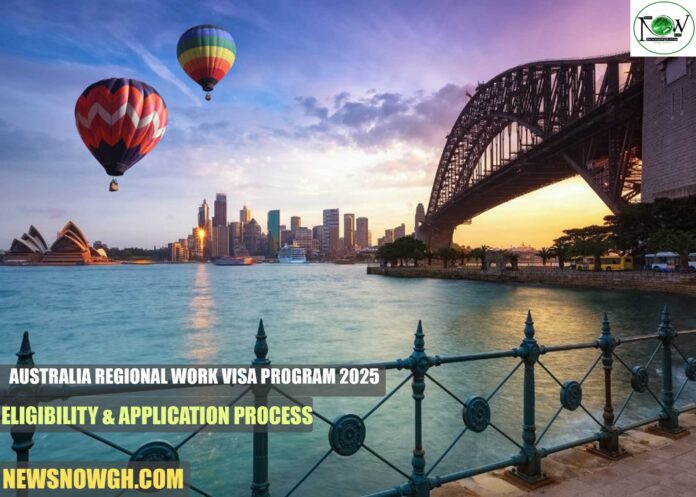Australia Regional Work Visa Program 2025: Eligibility & Application Process
Australia is increasingly attracting skilled workers from around the globe, with a strong emphasis on regional development. The Australian government aims to boost population growth, tackle labor shortages, and invigorate economic activity in areas outside major cities like Sydney, Melbourne, and Brisbane. For skilled professionals eager to work and live in regional Australia, various visa options are available.
If you’re contemplating a move to Australia without a job offer or seeking a more affordable lifestyle, regional work visa programs may be your ideal choice.
Understanding Regional Australia
Regional Australia encompasses all areas beyond the major metropolitan centers. This includes smaller cities and towns where skilled labor is in high demand. The government identifies eligible postcodes that qualify for special visa options and incentives.
Living and working in these regions can provide a quicker route to permanent residency and opportunities for state or territory nomination.
The Importance of Regional Migration
As major cities become overcrowded and job competition intensifies, the government promotes skilled migration to regional areas. This strategy supports local industries, including agriculture, healthcare, construction, and education. Migrants opting for regional areas enjoy several benefits:
- Easier visa requirements
- Increased chances of nomination
- Extra points in the immigration system
- Lower living costs
- Strong community support
Regional Work Visa Options
1. Subclass 491 – Skilled Work Regional (Provisional) Visa
This visa is valid for five years and requires nomination by a state or territory or sponsorship by a qualified relative in a designated regional area. It provides 15 additional points for nomination and requires you to live and work in regional Australia. This visa also leads to permanent residency through the Subclass 191 visa.
Eligibility:
- Age under 45 years
- Occupation on the relevant skilled occupation list
- Positive skills assessment
- Competent English (IELTS 6.0 or equivalent)
- Minimum 65 points on SkillSelect
2. Subclass 494 – Skilled Employer Sponsored Regional (Provisional) Visa
Also valid for five years, this visa requires a job offer from an approved regional employer. You must work in a designated regional area and may apply for permanent residency after three years via Subclass 191.
Eligibility:
- Occupation on the Regional Occupation List
- At least three years of relevant skilled work experience
- Skills assessment
- Age under 45 years
- Competent English
3. Subclass 191 – Permanent Residence (Skilled Regional) Visa
This visa grants permanent residency after living and working in regional Australia on a Subclass 491 or 494 visa for at least three years. Applicants must meet income requirements and comply with all visa conditions.
Application Process
- Skills Assessment: Apply through an authorized assessing body for your occupation.
- English Language Test: Complete an approved test like IELTS or PTE.
- Expression of Interest (EOI): Submit through SkillSelect to express interest in regional visas.
- State Nomination or Employer Sponsorship: Seek nomination for Subclass 491 or secure a job offer for Subclass 494.
- Invitation to Apply: Wait for an invitation to submit your visa application.
- Visa Application: Submit your application with the necessary documents.
- Health and Character Checks: Undergo medical exams and police clearances.
Regional Sponsored Migration Scheme (RSMS) Visa
The RSMS visa (Subclass 187) was a notable permanent residency option for skilled workers sponsored by regional employers. Although it has been replaced by newer visas like Subclass 191 and 494, understanding RSMS is beneficial for those exploring regional migration pathways.
This visa required employer sponsorship in a designated area and led to permanent residency after fulfilling work commitments.
Differentiating Regional Work Visa from Skilled Visa
The key difference between regional work visas and skilled visas lies in location and conditions. Regional work visas, such as Subclass 491, mandate living and working in designated areas, often requiring sponsorship or nomination.
Conversely, skilled visas, such as Subclass 189, allow work anywhere in Australia without the need for sponsorship. Regional visas offer additional points and incentives to encourage migration outside metropolitan regions.
Conclusion
Australia’s regional work visa programs present fantastic opportunities for skilled professionals eager to contribute to thriving communities beyond major cities. With pathways such as Subclass 491, 494, and 191, applicants benefit from reduced competition, additional points, and quicker routes to permanent residency. Embrace the chance to build a fulfilling life in Australia’s vibrant regional areas!
Follow NewsNowGh to stay updated on the latest information regarding work permits, visas, and visa-sponsored employment.


